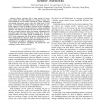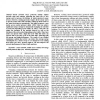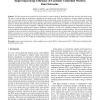66 search results - page 8 / 14 » Reducing Network Energy Consumption via Sleeping and Rate-Ad... |
IJWMC
2006
13 years 7 months ago
2006
IEEE 802.11 power-save mode (PSM) has been proposed in wireless LANs and multi-hop wireless networks to coordinate power states of wireless devices. In IEEE 802.11 PSM, power manag...
VTC
2008
IEEE
14 years 2 months ago
2008
IEEE
— Sensor networks with a large amount of sensor nodes usually have high redundancy in sensing coverage. The network lifetime can be further extended by proper scheduling and putt...
249
click to vote
Presentation
In this paper, we propose a decentralized method for maximizing lifetime of data collection wireless sensor networks (WSNs) by making minimal number of nodes operate and putting ot...
ICC
2007
IEEE
14 years 2 months ago
2007
IEEE
—Sensor network MAC protocols usually employ periodic sleep and wakeup, achieving low duty-cycle to save energy and to increase the lifetime of battery-powered sensor devices. Ho...
WINET
2002
13 years 7 months ago
2002
Wireless network access protocols can assist nodes to conserve energy by identifying when they can enter low energy states. The goal is to put all nodes not involved in a transmiss...



